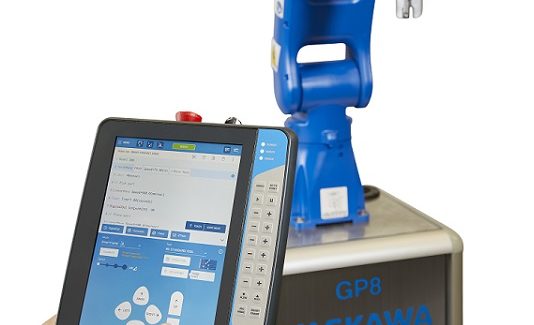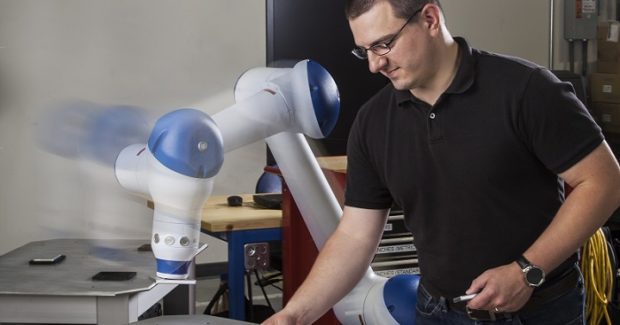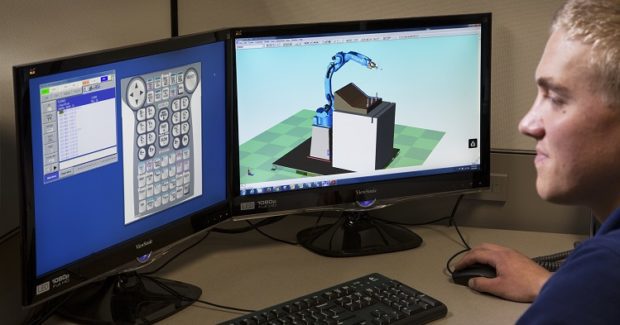Easy Robotic Automation for a Stronger Workforce and Better ROI
Smart manufacturing tools are helping shops of all sizes deal with labor shortages and production inefficiencies. When implemented and managed correctly, these tools can aid human workers, create a more productive workforce and increase overall competitiveness.
Posted: February 12, 2019
Metal fabricators of all sizes use robotic automation with feature-rich digital capability to achieve better quality products with faster performance. Yet new market dynamics and technological breakthroughs continue to disrupt and increase manufacturing complexity, prompting many shops to realign their strategy and gradually evolve their production facilities into intelligent factories. What exactly does this mean, and how can it really help?
THE NEED FOR SMART FACTORIES
Mass production has given way to mass customization, driving the demand for new systems on the factory floor that can increase production flexibility – but with increasing product individualization, shorter product life cycles and unique market demands, production inefficiencies continue to flourish across manufacturing. A chief concern is finding the talent to fill over two million manufacturing jobs within the next decade.1 Nearly 69 percent of manufacturers have been unable to attract and retain skilled workers needed to fulfill the tasks required to maintain highly productive operations.2 The combined use of smart methods with human-robot process automation helps to alleviate this disruption and fulfill diverse demands, fueling confidence in the benefits that innovative technology can provide. The record high optimism expressed by manufacturers at the end of 2018 stems in part from the growing number of more affordable and easy-to-use robots and technologies that are available to overcome production pitfalls, especially for non-welding applications.2
HUMAN-COLLABORATIVE ROBOTS
Optimized for safety and designed to work with or in close proximity to human workers without a hard safety enclosure, collaborative robots (cobots) can perform difficult, dirty and tedious tasks in an ergonomic and efficient way through the use of sensors and advance control software. Cobots provide easy and safe automation for a variety of applications, including assembly, packaging, palletizing, labelling, dispensing, machine tending, injection molding, quality inspection, pick and place, and lab analysis and testing. While traditional robots are still viable for a wide range of applications like welding, cobots effectively bridge the gap for non-welding applications in a high-mix, low volume setting. Simple to program for quick implementation, cobots adapt easily and can be integrated with existing automation infrastructure.
Smart tools, such as intelligent touchscreen teach pendants with built-in technology that eliminates the use of conventional coordinate (XYZ) frames, or intelligent robot features such as hand-guided teaching, simplify robot programming and allow easy command of the robot movement. Not all cobots are equipped with these capabilities, but those that are enable novice robot programmers to easily jog a robot.
LIGHTWEIGHT INTUITIVE TEACH PENDANTS
A key component for remaining competitive in today’s marketplace involves implementing smart technologies that help robots work more efficiently, flexibly and safely. The use of intuitive teach pendants, ergonomically designed to reduce programming fatigue, is no exception. Newer standard teach pendants offer intuitive graphic user interfaces with touchscreens for easy programming for both on-site operators and robot programmers. These pendants usually include multiple user levels that accommodate varying skill sets, as well as specific display options for applications like material handling. Convenient features, such as an SD card slot and USB port, allow easy loading of jobs programmed offline and provide storage for valuable robot jobs and setting backups. An integrated enabling switch allows users to operate the robot while meeting all safety requirements.
Besides standard teach pendants, intelligent touchscreen teach pendants are radically changing the way both robots and cobots are programmed. Designed using leading Human Machine Interface (HMI) features, these pendants are integrated with tools that make robot programming more intuitive and easier than ever: A “click and program” approach using touchscreen buttons allows users to guide robots via familiar programming commands, such as copy, cut, paste, undo and redo. Built-in Smart Frame technology – which operates within a frame of reference, moving left-right, up-down or away-toward – allows the robot to adapt to the position of the programmer. This results in easy jogging of the robot for new robot programmers, while offering a choice with no trade-off in terms of capability for experienced users.
COMPACT CONTROLLERS, LIGHTWEIGHT ROBOTS, CONTROL-BASED COLLABORATION
The uptick in multi-product manufacturing has prompted a growing trend toward warehouse design optimization. The need for flexible, easy-to-reconfigure factory layouts that achieve peak performance in a dynamic manufacturing environment is driving the implementation of more streamlined, lightweight robots with compact robot controllers that can be easily moved and positioned. This allows the use of high-density (sometimes vertical) workcells, reclaiming valuable floor space for other production stations. Similarly, the need to accommodate the mass production of parts introduces unique factory layouts where industrial robots are safeguarded to work in a collaborative manner with human workers. For this environment, a thorough risk assessment of potential hazards must be performed for each new application, and at least one of four modes of collaboration as defined by ISO 10218 (Safety-rated Monitored Stop, Speed and Separation Monitoring, Power and Force Limiting, and Hand Guiding) must be present.
While only cobots with power and force limiting can truly work alongside humans without additional safety hardware and process equipment, utilizing one of the other effective modes of collaboration can protect workers from potentially harmful contact situations. A popular mode of choice is safety-rated monitored stop. This is a component of a Functional Safety Unit (FSU) option, where external safety-rated laser sensors monitor any person entering a robot’s interactive space, communicating to the robot to slow down and stop.
SOPHISTICATED PROGRAMMING OPTIONS
For manufacturers that cannot afford to interrupt production, comprehensive offline programming software enables operator training, robot programming and optimization from a desktop computer anywhere in the world. This allows operators at any size company to have the power to create, test and adjust robot programs before they are implemented on the factory floor. This convenient style of programming helps to enable a higher mix of jobs with a simple transition from one job to the next, providing manufacturing flexibility. Larger companies with multiple plants and/or workcells can reduce their programming time and inconsistencies by using this software and distributing the programmed job from a central, controlled source.
FACTORY AUTOMATION MANAGEMENT SOFTWARE
Inspired by Industry 4.0, robotic automation and manufacturing processes are fueling a higher level of production efficiency and subsequent return on investment throughout the manufacturing sector by relying on an easily accessible flow of data. A key element to successful robot utilization is tracking the overall equipment effectiveness (OEE) throughout a production environment. This is made possible by implementing a systems management and control platform that visualizes the status, health and performance of factory equipment. Factory automation management software can actively monitor, accumulate and visually deliver real-time operations data through a Standard Open Platform Communication Unified Architecture (OPC-UA) interface, providing a unified controls approach where operational knowledge can be synchronized and shared throughout an extended enterprise or through external systems. When harnessed correctly and consistently, management can use this Big Data to gain valuable insights for production efficiency and global competitiveness.
References
1. The Skills Gap in U.S.Manufacturing: 2015 and Beyond, The Manufacturing Institute and Deloitte, 2015.
2. 2018 Fourth Quarter Manufacturers’ Outlook Survey, National Association of Manufacturers (NAM), 2018.



















